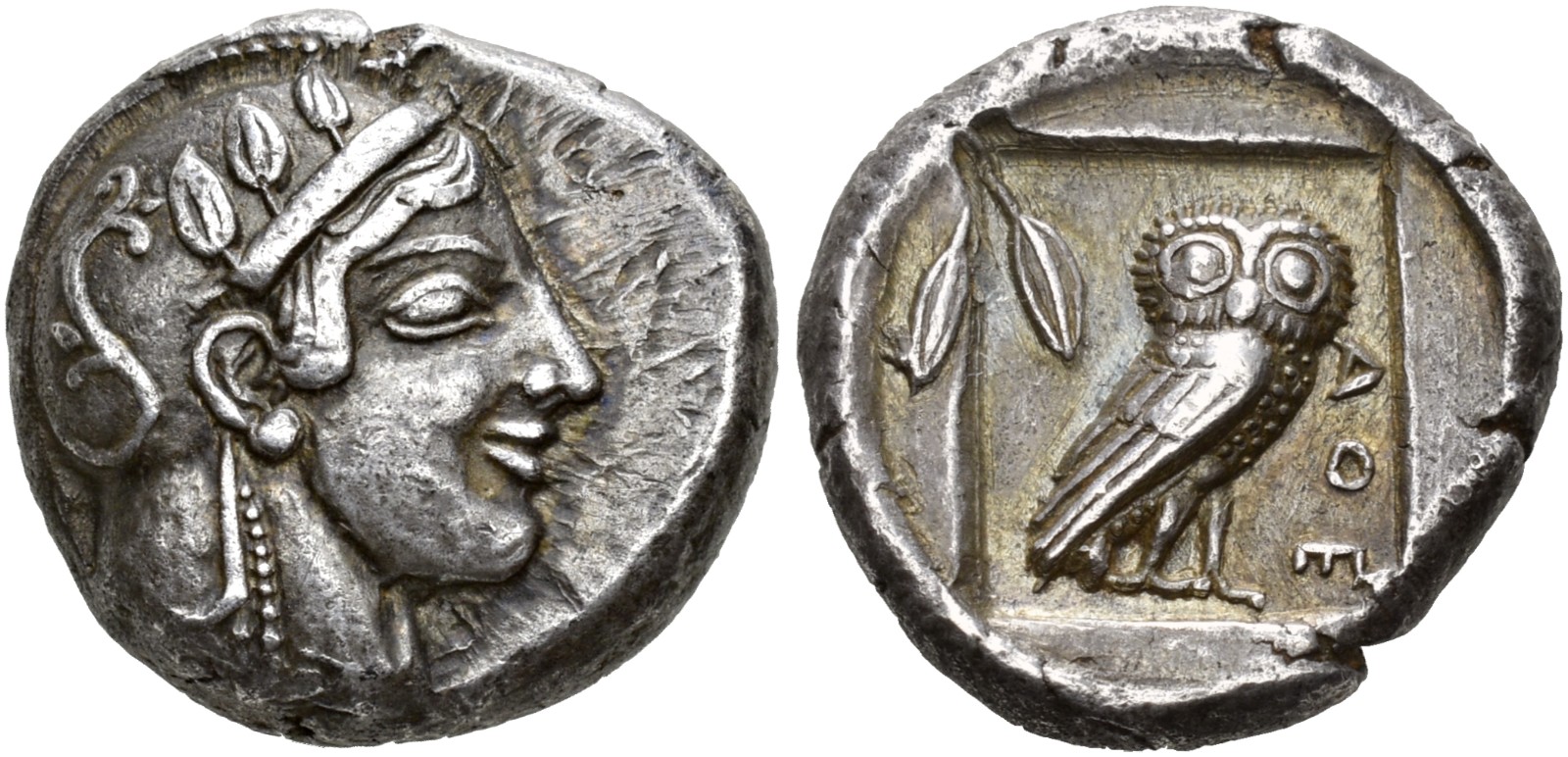AC 194 - Athens, silver, didrachms (475-449 BCE)
From SILVER
475 BCE - 449 BCE Silver 9,202 kg
Description
| ObverseInscription or printing placed on the obverse.: | Head of Athena r., wearing crested Attic helmet decorated with three olive leaves and volute, disc-shaped ear-clip and necklace |
| ReverseInscription or printing placed on the reverse.: | AΘE (Greek).Within incuse round, shallow incuse square, in which owl standing r., head facing, in field r., AΘE, l., two olive leaves, the l. one overlapping the frame |
Mint and issuing power
| MintIdentifies the place of manufacture or issue of a numismatic object.: | Athens | Ancient regionAncient region.: | Attica | Modern countryModern country: Greece | AuthorityIdentifies the issuing power. The authority can be "pretended" when the name or the portrait of X is on the coin but he/she was not the issuing power. It can also be "uncertain" when there is no mention of X on the coin but he/she was the issuing power according to the historical sources: |
Chronology
| FromIdentifies the initial date in a range assigned in a numismatic context. | 475 BCE | toIdentifies the final date in a range assigned in a numismatic context.. | 449 BCE | PeriodTime period of the numismatic object.: Classical 480-323 BC |
Physical description
| MetalThe physical material (usually metal) from which an object is made.: | Silver |
Median weightMedian of the weights of numismatic objects (in grams). in grams | 8.55 | DenominationTerm indicating the value of a numismatic object. Examples: tetradrachm, chalkous, denarius.: | didrachm |
StandardStandard.: | Attic |
Image

AC194 Athens didrachm.jpg [1]
References
| Die study referencePublication of the study: | Starr 19701Starr 1970, Groups II-IV | ||
| Coin series referenceReference to coin series study: | Sear I2Sear I, n° 2522, RQEMAC3RQEMAC, n° 194 | ||
Obverse dies distribution
| FrequencyFrequency of specimen in distribution. ᵖ | Number of obversesNumber of obverse dies. ᵖ (o) | % (o) | Number of coinsNumber of coins. (n) | % (n) | Die nameName(s) of the die(s). |
| 1 | 16 | 69.57 | 16 | 45.71 | 22, 23, 25, 37, 38, 65, 66, 68, 69, 71, 88, 89, 90, 121, 122 |
| 2 | 5 | 21.74 | 10 | 28.57 | 24, 39, 67, 70, 119 |
| 4 | 1 | 4.35 | 4 | 11.43 | 123 |
| 5 | 1 | 4.35 | 5 | 14.29 | 87 |
| Total | 23 of 23 | 100.01 | 35 of 35 | 100 |
Reverse dies distribution
no distribution is available
Quantification
| Number of obversesNumber of obverse dies. ᵖ (o) | 23 | Number of singletons (o1)The number of singleton coins. ᵖ | 16 |
| Number of reverse diesNumber of reverse dies. (r) | c. 26"c" can not be assigned to a declared number type with value 0.26. | Number of coinsNumber of coins. (n) | 35 |
| Coins per obverse dieNumber of coins per obverse die. (n/o) | 1.52 | Coins per reverse dieNumber of coins per reverse die. (n/r) | |
| Reverse per obverse ratioRatio of obverse dies divided by reverse dies. (r/o) | Percentage of singletons (o1)number of coins (n) divided by the number of singletons (o1) ᵖ | 69.57 % | |
| Original number of dies (O) (Carter 1983 formula)The estimation of the number of coins according to Carter 1983 ᵖ | 53.81 | Coins struck if 20,000 as average productivity per dieCoins made if the average productivity for obverses (according to Carter) is 20,000. ᵖ | 1,076,200 |
| Original number of dies (O) (Esty 2011 formula)The estimation of the number of coins according to the singleton formula in Esty 2011 ᵖ (O) | 67.08 | Survival rate if 20,000 as average productivity per dieSurvival rate if average productivity is 20,000. ᵖ | 0.00003 |
| Coverage (o = % of O) (Esty 1984 formula)Esty 1984 - coverage (% of O) ᵖ (o = % of O) | 54.29% | Die productivity if survival rate 1/2,000Average productivity if survival rate is 1/2,000. ᵖ | 1,300.87 |
| Weight of silver (in kg) if 20,000 coins per die (O = Carter formula)Carter 1983 * Median weight * 20000 (*10 if gold or electrum) ᵖ | 9,202 kg <br /> 9,202 kg | Die productivity if survival rate 1/5,000Average productivity if survival rate is 1/5,000. ᵖ | 3,252.18 |
Remarks